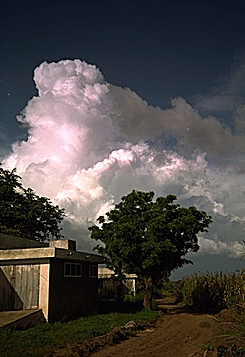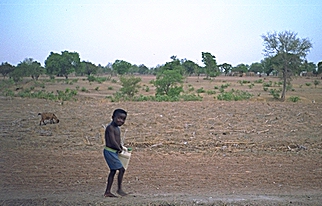

 |
Navrongo and Lawra are in the guinea savannah of the Upper East and Upper West Regions of Ghana, West Africa respectively. Both are on the border of Burkina Faso, Ghana's northern neighbor.
The two Upper Regions, Upper East and Upper West, have had their borders redrawn twice since Ghanaian Independence from Great Britain in 1957. At Independence, they were both part of the Northern Territories, a vast
region which covered the northern half of the country. To ease the administrative burden on the Northern Region therefore, an Upper Region was created out of the Northern Region to coincide with Ghana's attainment of Republican status on 1st July 1960. In 1983 the Upper Region was sub-divided into the Upper East and Upper West regions, again for administrative convenience.
The Upper East Region is one of the smallest in the country, larger only than the Greater Accra Region. Its administrative capital is Bolgatanga, and other important towns are Bawku, Zuarungu, Zebilla, Sandema, and of course, Navrongo.
The Upper West Region, while created by the Ghanaian Government in 1983, was formally inaugurated in 1987. It is fast bridging the development gap between it and the rest of the country. The economy is mainly agricultural with high potential for animal, cotton, sheanut, and grain production. The administrative capital is Wa, which has a very beautiful mosque. The Wa chief, the Wa Na, also has an attractive palace. One can also tour the Gbede Game Production Reserve to the north of Wa. Other important towns Nandom, Tumu, Jirapa, and of course, Lawra.
The rural populations around Lawra and Navrongo live in settlements which consist of compounds made primarily of mud and thatch. They are both district capitals with approximately 10,000 people.
Navrongo is the district capital of the Kassena-Nankani District which has a population estimated at 175,000 with the majority of the people living in rural dispersed villages. The people of the Kassena-Nankana District belong to the Mole-Dagbani cultural groups, one of the major ethnolinguistic groups of the northern regions of Ghana and neighboring Burkina Faso. In this sense, the Kassena-Nankana are more closely related to the cultures of neighboring Sahelian countries than of peoples of coastal Ghanaian regions. About 51 percent of the district's population speaks Nankam, 47 percent speaks Kassim, and the balance speaks mainly Buili. Although these languages differ, these cultural groups share common customs of religion, lineage, marriage, and family structure. Although Kassena and Nankana ritual practices differ somewhat, similarities outweigh differences.
Lawra is the district capital of the Lawra District in the Upper West Region. Here's a map of Lawra and its nearby villages. Dagaare is the main language in Lawra.
Both towns enjoy a few of the creature comforts you on the other end of the terminal are familiar with. Navrongo has 24 hr electricity from the country's main source of power, the Akosombo dam near the capital city of Accra. Lawra's power is periodic and comes from diesel generators. Water is a precious commodity in the North of Ghana. Both towns have some access to running water (however sporadic) but those immediately outside the town must pump their water from boreholes by hand. Most people travel by foot or bicycle. The main bicycle sold is the Chinese made Phoenix. It is aptly named as this one-speed 40 pound hulk of steel often dies and is reborn again and again in the hands of one of the numerous bike repair shops around town.

Economics
|
Navrongo and Lawra are in very rural districts. Almost everyone is a subsistence farmer with some other job on the side. Principle crops are millet, corn, groundnuts (peanuts), rice, and sorghum. Unfortunately, when the rains fail and the crops die, hunger is not far behind as most people get by year to year. Livestock such as chickens, goats, sheep, pigs, and cattle are also raised.
There are thriving markets in both Navrongo and Lawra. Grains, yams, vegetables, poultry, livestock, and second-hand clothes from the West are bought and sold using the Ghanaian currency - the cedi. The Lawra market seen at the left meets once every six days while the Navrongo market meets once every three days. Both towns have direct bus connections to the capital city Accra at least once a week. A direct trip when the roads are good can take 14 hours to travel 500 miles. Some of the roads are so bad (e.g., Bolgatanga-Tamale road) that 100 miles can take over eight hours during the rainy season! |

Weather
There are three distinct seasons: Rainy, Dry, and Hot. The rainy season starts in May and ends in September. This short season only allows for one crop cycle. Rainstorms usually last no longer than an hour and are very violent. These storm clouds to the right are building into a big storm. Flash floods are common and ravines usually dry, turn into turgid and turbulent rivers. The rainy season only allows for one crop cycle. | 
|
As October rolls around and the Dry season starts, the temperatures drop from the high 90's down to the mid 80's. The clouds disappear from the sky and the relative humidity drops to 10%! Even more dramatic is the dusty wind off of the Sahara called the Harmattan. It coats everything not moving too quickly with a thin layer of white dust. On particularly bad days visibility is reduced to 100 meters and the usually unforgiving Sun is simply a whitish haze in the sky.

|
On the left is Robert going to the borehole to collect his water. You can see how dry and brown the land is! Also behind Robert is a typical goat that eats everything and anything. (They especially like to eat young mango tree seedlings that you plant. The only good goat is the one in your groundnut stew.) |
By March the Harmattan dies down and the Sun is directly overhead. Temperatures can easily reach 110 °F and life slows to a crawl. In the mid-day heat everyone finds their favorite shade (usually a mango tree which also happens to be bearing fruit this time of the year) and tries not to move to much. When the first rain falls and softens the hard, desiccated earth, people start getting ready for a new farming season and the cycle continues.

© MCMXCVIII All Rights Reserved